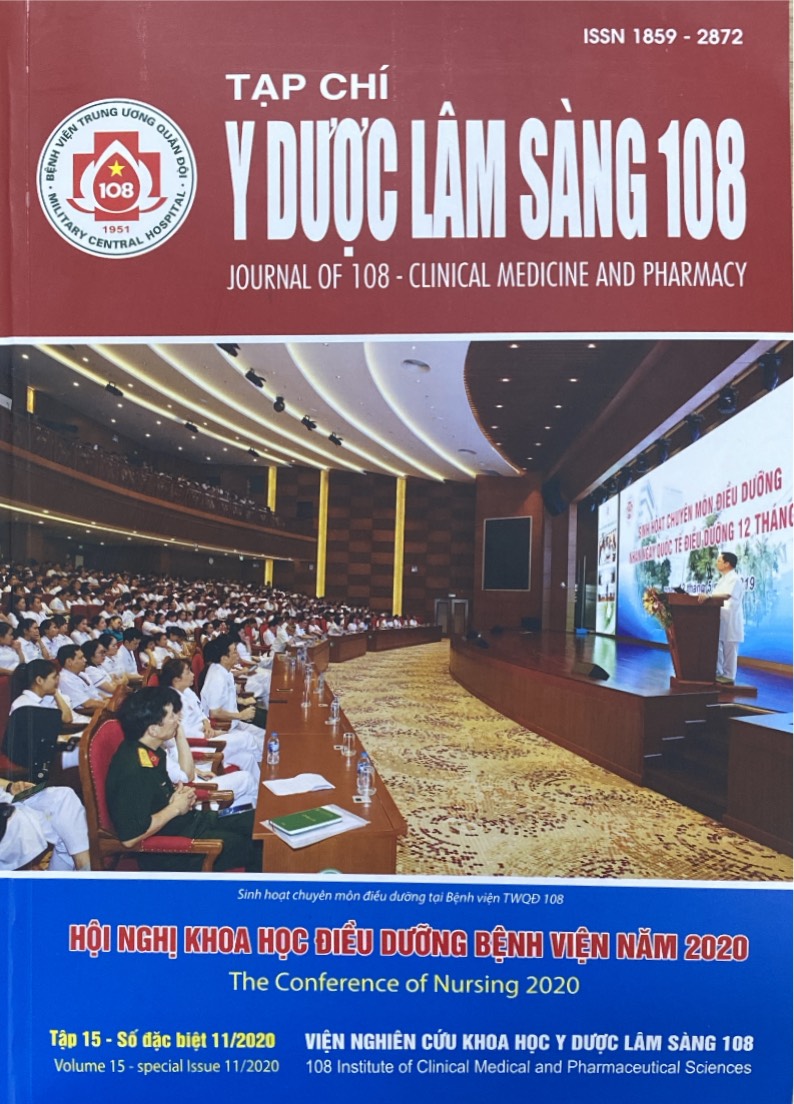Evaluating postoperative pain after caesarean section under spinal anesthesia at Department of Gynaecology - 108 Military Central Hospital
Main Article Content
Keywords
Abstract
Objective: To evaluate postoperative pain status of women after caesarean section under spinal anesthesia and medications for pain relief. Subject and method: A prospective, cross-sectional study on 115 women who underwent caesarean section under spinal anesthesia at Department of Gynaecology, 108 Military Central Hospital, from January 1st to March 1st 2020. Pain assessment was done using VAS score. Result: Mean age was 29.0 ± 4.1 years old. Pain occurred mostly at the first day after caesarean section, with mean VAS score at the sixth hour and 24th hour was 5.88 ± 1.35 and 4.7 ± 1.8, respectively. The rate of women with VAS score > 6 at sixth hour and 24th hour was 39.1% and 16.5%. All of women (100%) were given NSAIDs for pain relief after caesarean section for 24 to 48 hours, but none needed opioid. Conclusion: Pain in women with caesarean section under spinal anesthesia occurs mainly in the first 24 hours, requires pain relief by only using NSAIDs but not opioid.
Article Details
References
2. Phan Đình Kỷ (2002) Gây mê mổ lấy thai. Bài giảng Gây mê hồi sức, Trường Đại học Y Hà Nội, Nhà xuất bản Y học, 2, tr. 274 - 298.
3. Nguyễn Viết Quang (2014) Đánh giá tác dụng gây tê tủy sống bằng hỗn hợp bupivacain và fentanyl liều thấp ở sản phụ mổ lấy thai cấp cứu. Y học Thực hành, 1, tr. 54-56.
4. Nguyễn Thế Tùng (2008) Đánh giá tác dung gây tê tủy sống băng hỗn hợp bupivacain liều thấp kết hợp fentanyl trong mổ lấy thai. Luận văn Thạc sĩ Y học, Học viện Quân y.
5. Phạm Đông An, Nguyễn văn Chừng (2004) Hiệu quả của gây tê tủy sống bằng hỗn hợp bupivacain (marcain) và fentanyl trong mổ lấy thai. Tạp chí Y học Thành phố Hồ Chí Minh, Trường Đại học Y Dược Thành phố Hồ Chí Minh, 8(1), tr. 71-76.
6. Carvalho, B.M.F (2014) Strategies to optimize pain control following cesarean delivery. Miscellaneous article. ASA Refesher Courses in Anesthesiology, 42(1): 23-30.
7. Eisenach JC, Pan PH, Smiley R et al (2008) Severity of acute pain after childbirth, but not type of delivery, predicts persistent pain and postpartum depression. Pain 140: 87-94.
8. Rosaeg OP, Lindsay MP (1994) Epidural opioid analgesia after caesarean section: a comparison of patient-controlled analgesia with meperidine and single bolus injection of morphine. Can J Anaesth 41(11): 1063-1068.
9. Ngiam SKK, Chong JL (2011) The addition of intrathecal sufentanil and fentanyl to bupivacain for caesarean section. Singapore Medical Journal: 1- 8.
10. Jung Hyang Lee, Kum Hee Chung et al (2011) Comparison of fentanyl and sufentanil added to 0.5% hyperbaric bupivacain for spinal anesthesia in patients undergoing cesarean section. Korean journal of anesthesiology 60(2): 1-11.
11. Kleinman W, Morgan GE, Mikhail MS, Murray MJ (2002) Spinal, epidural and caudal block. Clinical Anesthesiology, McGraw-Hill 3: 253-282.
 ISSN: 1859 - 2872
ISSN: 1859 - 2872
